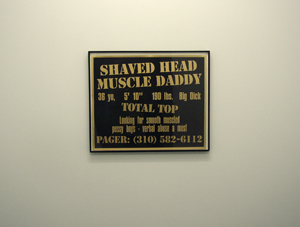
Gallery
Address:
119 N Peoria St, Suite 2A
Chicago, IL 60607 USA
312.480.8390
Gallery hours:
Wednesdays - Saturdays
11am to 6pm
send email
Show dates:
May 24 to June 28, 2008
In Gallery Two
Dead Center / Marginal Notes:
John Boskovich | images
Dead Center / Marginal Notes: John Boskovich is the third in a yearlong series of shows curated by John Neff for Western Exhibitions' Gallery Two. Each show in the program will present one piece each by two artists or a small selection of works by a single maker. All of the works exhibited will deal – directly or indirectly – with the relationships of centers to margins (culturally, geographically, politically and within works themselves as a formal concern). The third show in the series, opening May 24th, presents works by the late Los Angeles-based artist John Boskovich.
Dead Center / Marginal Notes: John Boskovich focuses on works from the artist's 1993 Rosamund Felsen Gallery solo exhibition Rude Awakening. It also includes three related Polaroid and text pieces from the 1990s "It Series." Western Exhibitions' display centers on extant components of Boskovich's project-cum-installation The Honey Machine: It Works Without Thinking, which was first shown in Rude Awakening. In a 1994 Artforum review, critic David Rimanelli described the installation:
Embers smolder in "The Honey Machine: It Works Without Thinking", an installation in which Boskovich has assembled 250 Honey Bears and miniature Buddhas and encased them in three Plexi vitrines. In the role of artist-as-researcher (cf. Hans Haacke), Boskovich counted for six months the number of ads placed by "models" (read: hustlers) in Frontiers, a California gay magazine. The number was always close to, and sometimes exactly, 250. The comforting little surrogates for the 250 advertised pleasure-workers all face a framed text of an ad Boskovich took out in Frontiers bearing this inviting text: "SHAVED HEAD MUSCLE DADDY 36 yo, 5'10" 190 lbs. Big Dick TOTAL TOP Looking for smooth muscle pussy boys--verbal abuse a must PAGER: (310) 582-6112." The pager was hooked up to a sound system installed in the gallery, and the voices of respondents would often interrupt a prerecorded tape featuring, among other things, Patti Smith performing "Piss Factory," Allen Ginsberg reading his depressing poem, "Aunt Rose," and T. S. Eliot intoning passages from "Four Quartets."
In the fifteen years since Rude Awakening, several of the elements described by Rimanelli have been lost. Rather than attempting to recreate The Honey Machine as it was initially presented, Neff has chosen to include only surviving original elements of the installation in Dead Center / Marginal Notes. Those elements include the framed text piece Daddy and Frontiers, a framed magazine containing Boskovich,s actual advertisement. The perishable Honey Bears and fragile Buddha figurines have disappeared: if a tape of the respondents to Boskovich's advertisement exists, its location is unknown.
Two live audio cables protruding from the wall and terminating, unconnected to any machine, on the gallery floor mark the absence of the installation's audio track, and of Boskovich's carefully selected playback devices. The visual contrast between Western Exhibitions' austere gallery display and 1993 documentary photographs of The Honey Machine also indicates the fragmentation of Boskovich's installation over time. The curator hopes that these specific differences in presentation suggest the difficulties of preserving and exhibiting conceptual artworks outside of collecting institutions, while simultaneously pointing to the ways in which Boskovich's art generally could be said to allegorize the gaps and ruptures – baffling or productive – that inhere in relationships between humans and images, or relationships between humans through images.
More on Dead Center/ Marginal Notes here
ALL IMAGES © WESTERN EXHIBITIONS & EACH INDIVIDUAL ARTI
